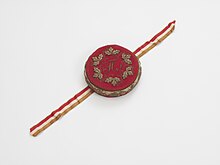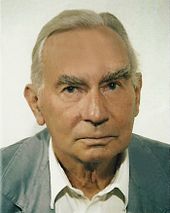Corps Hansea Koenigsberg
The Corps Hansea Königsberg was a Kösener Corps at the Königsberg Albertus University.
history
The Arminia III fraternity, founded in 1860 in the Eisenach Deputy Convent , had special relationships with the SC. When Masovia resigned from the SC, she immediately concluded a pounding relationship with them. However, soon after the start of the winter semester, Arminia was involved in proceedings aimed at dissolution by the Senate of the Albertus University in Königsberg . Its members had participated in several pistol manu-factures. After a decision that was unfavorable for Arminia was announced, an appeal was lodged with the Prussian Ministry of Spiritual, Educational and Medical Matters without success ; the members of the Arminia did not want to give in. During the deliberations on how the federal government could be reopened, the conviction was formed that a new fraternity would have difficulties with the Senate under a different name ; but it was precisely for this reason that the opinion penetrated to set up a corps . In addition, five Masurians did not agree with the behavior of their CC and promised the fraternity members to support them in their project.
Reichsdeutsches Corps in East Prussia
On December 16, 1876, the Corps Hansea was registered with the university. She raised no concerns about the foundation. The corp table of the Hansea shows a total of 67 names for the years 1876/77. Less the members of the active CC of these years, around 50 members of the former Arminia fraternity should have converted to the Corps Hansea. Hansea took on the colors red-white-gold. The motto was: United and Free! The color of the hat was fox red. A fox ribbon was introduced immediately. These colors changed from red-white-red to white-red-white over time. On January 18, 1877, the new corps was accepted into the Königsberg Seniors 'Convent and thus into the Kösener Seniors' Convents Association . Hansea had to denounce three protested complaints since May 27, 1882 and was suspended from June 3 to July 27, 1882; the sentence ended on December 3, 1882.
The name Hansea made no connection to an East Prussian landscape. It only reminded of the Hanseatic League , which Konigsberg had belonged to. Hansea did not want to be an East Prussian, but “a Reich German corps in East Prussia”. The fraternity legacy emerged, namely the national liberal and at the same time German national direction.
The Hanseatic people “led a simple life” and had their favorite pub at Novopolski on Königsberg Castle Pond , at Domscheit since 1888 and at the Schützenhaus since 1894. In 1903 Hansea bought a house at Münzstrasse 2. In the lower rooms of Hansea's corp house , the Kgl. Court photographer JS Schroeder opened his shop. A large glass box was built towards the garden, in which pictures could be taken in daylight. There was no flash or spotlight yet. Since 1927, Hansea had the second corp house at Handelstrasse 12 on Hufenfreigraben.
Due to a lack of young talent, the suspension threatened in the winter semester of 1892/93 . It was prevented by two Hessen-Nassauers and a Greifswald Prussia . In 1893, Hansea was also able to perform the on-site tasks and, with Gustav Bachus, was the chairman of the oKC.
The End
After Baltia , Masovia and Littuania , Hansea suspended on July 7, 1936 as the last Königsberg Corps. From 1938 she looked after the comradeship with Littuania with the final name "Tannenberg". In World War II, fell 15 Hanseaten.
Albertina
Five Hanseatic, nine Balts and eight Littau founded the Corps Albertina Hamburg on March 12, 1950 in the SC zu Hamburg . Of the 101 old Hanseatic residents, a total of 65 joined the Albertina AHV by 1960. Hansea expired on May 20, 2001.
Relative Corps
The first befriended corps were Rhenania (later Borussia) Berlin (WS 1877/78) and Marcomannia Breslau (WS 1878/79). Marcomannia soon broke up the relationship. In the winter semester of 1883/84, Hansea decided to join the black circle . Instead, she broke the friendly relationship with Borussia Berlin and the conceptual relationships with Hasso-Borussia , Starkenburgia , Borussia Halle , Lusatia Leipzig and Borussia Tübingen . At the turn of the century , Hansea was firmly anchored in the black circle and was highly regarded. Most recently she was in the following relationships:
- Cartels
- Borussia Greifswald (1898)
- Thuringia Jena (1901)
- Hasso Nassovia (1920)
- Thuringia Leipzig (1922)
- Rhenania Bonn (1934)
- Friends
- Brunsviga Göttingen (1897)
- Normannia Berlin (1920)
- Silesia (1920)
- Suevia Munich (1920)
- Saxonia Kiel (1928)
- imaginations
- Hassia (1899)
- Franconia Tübingen (1927)
Königsberg Hanseatic League
- Paul Albrecht (1851-1894), philologist
- Fritz von Bramann (1854–1913), surgeon
- Carl Dorno (1865–1942), founder of radiation climatology
- Max Draeger (1885–1945), President of the Königsberg Higher Regional Court, executed
- Franz Eschle (1859–1918), physician, director of nursing homes in Baden
- Curt Godlewski (1880–1959), President of the Reich Statistical Office
- Wilhelm Haberling (1871–1940), medical historian
- Hanswerner Heincke (1905–1986), philologist
- Eduard Hinze (1898–1986), general physician
- Bruno Huguenin (1880–1964), lawyer in the cooperative system
- Gustav Lastig (1844–1930), legal scholar
- Friedrich Ossig (1912–2004), lawyer with the Reichsbahn and the Bundesbahn, historian of the Corps
- Kurt Poll (1886–1943), District Administrator in East Prussia and in the Free City of Danzig
- Arthur Carl Rentel (1869–1951), Pomeranian Provincial Councilor, General Director of the Pomeranian Fire Society and Provincial Life Insurance Institution
- Ernst Schultz (1862–1919), mathematician, teacher in West Prussia, Dortmund and Duisburg
- Max Sitzler (1875–1952), curator of the University of Kiel
- Herbert Ziemer (1888–1975), District Administrator
- Emil Zimmermann (1850–1915), Latinist, high school teacher in East Prussia
See also
literature
- FG Ossig: Contributions to the history of the corps in the Hansea . Offenbach 1967.
- Siegfried Schindelmeiser: The Albertina and its students 1544 to WS 1850/51 and the history of the Corps Baltia II zu Königsberg i. Pr. Munich 2010, ISBN 978-3-00-028704-6 .
- Historia Academica, Vol. 34, p. 141.
- KSCV Handbook 1985, Vol. 2, 1/35, 1/47.
- Michael Doeberl , Otto Scheel , Wilhelm Schlink , Hans Sperl , Eduard Spranger , Hans Bitter and Paul Frank (eds.): The Academic Germany . 4 volumes, 1 register volume by Alfred Bienengräber. CA Weller Verlag, Berlin 1931, here vol. 2, p. 909.
Web links
- Literature by and about Corps Hansea Königsberg in the catalog of the German National Library
Individual evidence
- ↑ a b c Paul Gerhardt Gladen : The Kösener and Weinheimer Corps. Their representation in individual chronicles . WJK-Verlag, Hilden 2007, p. 76.
- ^ A b c F. G. Ossig: Contributions to the history of the corps in the Hansea . Offenbach 1967
- ↑ Schindelmeiser, Vol. 1, p. 259
- ^ Ernst Hans Eberhard : Handbook of the student liaison system. Leipzig, 1924/25, p. 82.
- ↑ Bachus later also became a member of the Corps Thuringia Jena.




